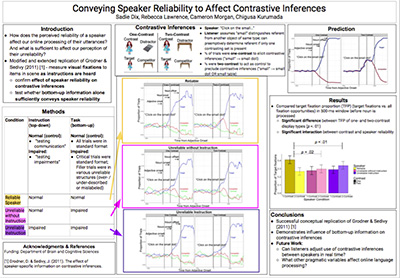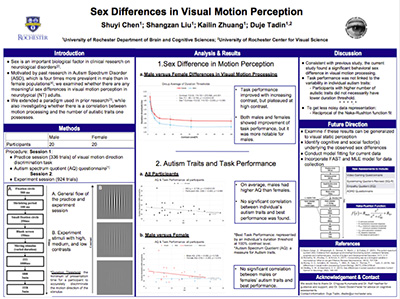BCSC 206: 2018-2019 Projects
Project Description
Background: As we are comprehending language, we develop interpretations without waiting until the ends of words, phrases or sentences. This process requires predictive and continuous coordination of different types of linguistic as well as non-linguistic information. Recent studies have proposed that this information coordination mechanism is further modulated according to the comprehender's assumptions about the speaker. For instance, when comprehenders believe that the speaker has an impairment that causes language and social problems, they may expect the linguistic input to be less reliable and adjust their comprehension behavior accordingly. This line of research uncovers how the bottom-up linguistic input and the top-down expectations and assumptions may constrain each other to guide real-time language processing.
PI: Kurumada (Tanenhaus)
Paper: Grodner, D. J., & Sedivy, J. C. (2011). The effect of speaker-specific information on pragmatic inferences. In E. Gibson., & N. Pearlmutter (Eds.) The processing and acquisition of reference. pp. 239-272.
Study: Experiment 1: Suspension of predictive eye-movements based on pronominal adjectives
Summary: Subjects are randomly assigned to one of two conditions and eye-tracked as they follow verbal instructions to manipulate objects on a computer screen. Target instructions contain a pre-nominal adjective (e.g., "Click on a tall glass"), which usually triggers anticipatory eye movements to a target object (e.g., a tall glass) when a contrasting object (e.g., a small glass) is also present. However, when subjects are told that the speaker has an impairment that prevents her from making logical uses of prenominal adjectives, such anticipatory eye movements were no longer observed. The results suggest that subjects' real-time language comprehension behavior is modulated in a speaker-specific fashion according to their expectations about the utility of linguistic signals.
Impact: This is a pioneering study that opened up a number of avenues of research questions regarding the rationality and automaticity of pragmatic processing in real-time sentence comprehension. This is, however, the only study thus far that showed effects of top-down information about the speaker on the time-course of real-time eye movements. It is yet to be established whether the results are reliably replicable.
Skills Required
Simple stimulus/response programming, R

UR Expo Poster (PDF)
Project Description
Background: The confirmation bias is one of the most ubiquitous and arguably consequential cognitive biases documented. When presented with multiple pieces of information sequentially, humans (and animals) often overweigh evidence presented early on in the sequence, at the expense of evidence presented later in the sequence. Furthermore, this bias can not just be observed in cognitive contexts in which it is usually studied, but also during sensory processing and perceptual decision-making. Interestingly, there is a discrepancy in the existing literature with some studies find an overweighing of early evidence (also called a primacy effect), while others find that most recently presented evidence has the largest influence on the decision (a recency effect). Understanding the nature and origin of those differences in a perceptual context that allows for rigorous and well-controlled experiments, and even neurophysiological studies in animals, has the potential to also shed light on the neural basis of the confirmation bias in high-level cognitive contexts.
PI: Haefner
Paper: Lange et al. (2018) Computational Cognitive Neuroscience conference; Lange et al. (2018) in preparation
Summary: Subjects are given the task to identify a pattern embedded in a noisy 1 sec long visual stimulus presented on the screen. Over the course of the 1 sec long trial, the noise changes in a way that allows one to compute at what time during that trial the image on the screen had the largest impact on the final decision. The experiment tests a prediction based on a mathematical model of cortical processing under what conditions subjects should weigh early images more than later images, and vice versa. Varying the noise (or uncertainty about the pattern) in two qualitatively different ways, subjects are predicted to show a confirmation bias in one condition, but not the other one.
Impact: While the chance that the results from this study cannot be replicated is small (but non-zero since the study has not been published or replicated), the replication a) teaches essential psychophysical techniques applicable to most studies in the field and b) lays the foundation for a number of interesting extensions to study the factors that determine how susceptible subjects are to a confirmation bias that could be carried out in the 2nd semester.
Skills Required
Programming
Project Description
Background: There is strong evidence for the gender similarities hypothesis that, on average, men and women perform similarly on most cognitive tasks (Hyde, 2005, American Psychologist). Similarly, there is very little evidence for sex differences in low-level visual processing. This is why it was very surprising for us to find a large sex difference in visual motion processing (Murray et al., 2018). We were using this task to study processing differences in individuals with autism spectrum disorder (ASD). ASD has a large sex bias, with boys about four times more likely to be diagnosed with ASD than girls. Because of this, after data collection, we included sex as one of our factors in the analyses of the non-ASD participants. From there, the sex-difference became immediately apparent--we found that, on average, males required a shorter stimulus presentation duration than females: across three separate experiments, females required between 27% and 78% longer presentation durations. As this result was unexpected, we reached out to other investigators who have used this task so that we could confirm the findings in other laboratories and with larger samples of subjects. As a result, our paper includes three independent replications of our main finding.
PI: Tadin
Paper: Murray, S.O., Schallmo, M-P., Kolodny, T., Millin, R., Kale, A., Thomas, P., Rammsayer, T.H., Troche, S. J., Bernier, R.A. & Tadin, D. (2018) Sex differences in visual motion processing. Current Biology, https://doi.org/10.1016/j.cub.2018.06.014
Fall Semester Study: Replication of both the observed sex difference and tasks where we did not find any differences between females and males (in the Current Biology paper we would that the observed sex difference cannot be explained by general differences in speed of visual processing, overall visual discrimination abilities, or potential motor-related differences—none of these abilities differed between males and females)
Summary: : In this task, subjects will view brief video clips of moving black and white bars and simply report whether the bars were moving to the left or to the right. For each subject, we will adjust the duration of these video clips to find the minimum amount of time needed for the individual to accurately perceive stimulus motion direction. The basic experiment for this task has already been programed.
What next: : In that paper, we reported an unexpected discovery, and at this point we have more questions than answers. What is unique about this task is that faster motion perception does not necessarily indicate better motion perception. In fact, shorter duration thresholds (i.e., ostensibly "better" performance) have been found in older versus younger individuals (Betts et al., 2004, Neuron) and in people with ASD versus typically developing individuals (Foss-Feig et al., 2013, J Neuroscience). In fact, one can achieve lower thresholds by temporarily suppressing the key motion processing area of the brain (Tadin et al., 2011, J Neuroscience). In particular, a key part of our results with males resembles previously published findings in ASD, which might be of significance given that ASD is much more prevalent in males. So, future research might look at whether autism traits in general population predict thresholds in this task. We also aim to follow this up with more structured research to elucidate what might be driving this difference between males and females. It will be interesting to determine whether this observation is specific to motion, or whether it extends to other domains.
Skills Required
Programming skills, basic statistics, data analysis and working with human subjects

UR Expo Poster (PDF)
Project Description
Background: Spatial attention is the process of focusing cognitive/neural resources on a particular object/location in the environment. When spatial attention is deployed covertly an area of the visual field is attended without actually directing the gaze toward it. Spatial covert attention enhances visual perception (e.g., the ability to detect or discriminate stimuli) at the attended location, whereas performance is impaired at unattended locations.
PI: Poletti
Paper: M. Carrasco, Visual attention: The past 25 years, Vol. 51, Issue 13, Pages 1484-1525, Vision Research, 2011
Study: Experiment 1: Perceptual benefits associated with covert spatial attention.
Summary: This experiment intends to replicate the well-known effect of covert attention using a spatial cueing (Posner) paradigm. While subjects maintain fixation, a central cue appears indicating the location in the visual periphery where the target is more likely to be presented. Following a short delay, four stimuli appear at different locations in the visual periphery. After the stimuli disappear subjects report the orientation of the stimulus (the target) previously presented at the location indicated by a following response cue. The target location could match (valid trials) or not (invalid trials) the location indicated by the central cue. In Neutral trials none of the locations is cued. These trials provide a baseline, that is, the ability to discriminate the target when attention is not focused at a specific location. Most of the non-neutral trials are valid (~75%). Performance is measured and compared across different trial types, and at different temporal intervals between the presentation of the cue and the target. Subjects are instructed to maintain their gaze at a central fixation point throughout the trial. Eye position is monitored to ensure that the gaze is maintained at the central fixated location. Performance is expected to be higher in the Valid trials, when attention is already focused at the target location, compared to Neutral and Invalid trials.
Suggested Experiment 2 for the 2nd semester: Investigate the influence of microsaccades on the deployment of covert spatial attention.
Generally, spatial cueing paradigms do not control for microsaccades, tiny saccades of less than half a degree in size, often occurring during fixation. The role of these microscopic gaze shifts in driving attentional effects is matter of debate. The effect of covert attention, measured as the difference in performance between valid and invalid trials, can be evaluated and compared in the presence and in the absence of microsaccades. To this end, trials with and without microsaccades in the interval between the cue and the target will be analyzed separately. Questions that can be addressed with this experiment: 1. is the attentional effect still present in the absence of microsaccades? 2. Is the direction of microsaccade influenced by the central cue? 3. Is microsaccade direction and amplitude related with the size of the attentional effect?
Impact: The results of Experiment 1 will replicate the findings of classical studies on covert attention, showing how top-down control of attention influences visual perception.
Skills Required
Programming skills, basic statistics, data analysis, working with human subjects and eyetracking.
